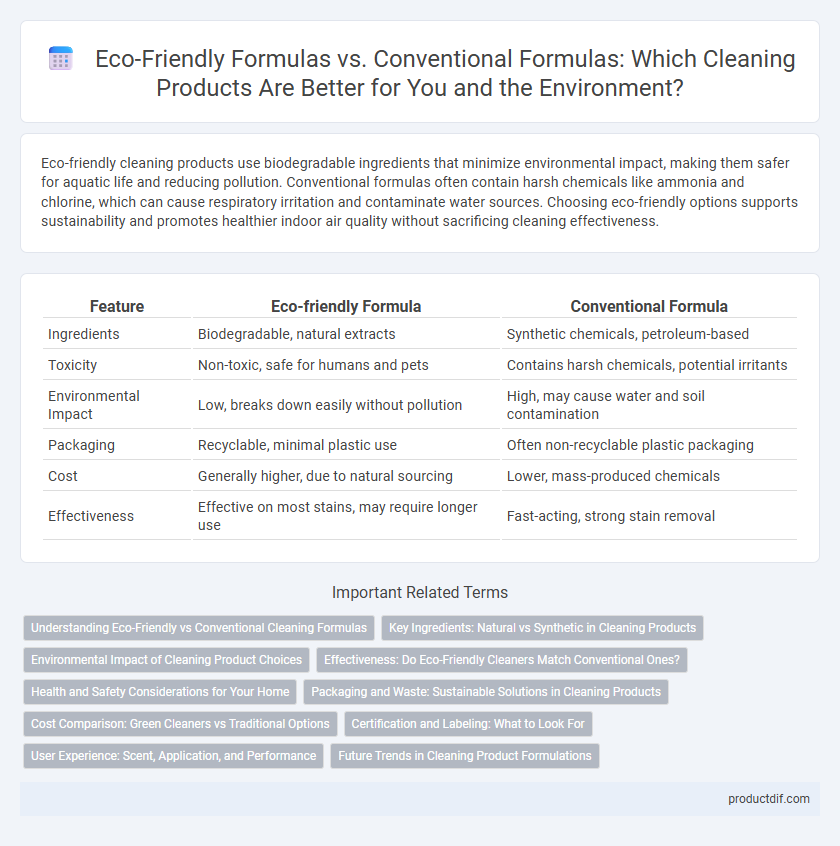Eco-friendly cleaning products use biodegradable ingredients that minimize environmental impact, making them safer for aquatic life and reducing pollution. Conventional formulas often contain harsh chemicals like ammonia and chlorine, which can cause respiratory irritation and contaminate water sources. Choosing eco-friendly options supports sustainability and promotes healthier indoor air quality without sacrificing cleaning effectiveness.
Table of Comparison
| Feature | Eco-friendly Formula | Conventional Formula |
|---|---|---|
| Ingredients | Biodegradable, natural extracts | Synthetic chemicals, petroleum-based |
| Toxicity | Non-toxic, safe for humans and pets | Contains harsh chemicals, potential irritants |
| Environmental Impact | Low, breaks down easily without pollution | High, may cause water and soil contamination |
| Packaging | Recyclable, minimal plastic use | Often non-recyclable plastic packaging |
| Cost | Generally higher, due to natural sourcing | Lower, mass-produced chemicals |
| Effectiveness | Effective on most stains, may require longer use | Fast-acting, strong stain removal |
Understanding Eco-Friendly vs Conventional Cleaning Formulas
Eco-friendly cleaning formulas utilize biodegradable ingredients and plant-based surfactants that minimize environmental impact and reduce harmful chemical residues in indoor air. Conventional formulas often contain synthetic chemicals, phosphates, and petrochemicals, which can contribute to water pollution and pose health risks due to volatile organic compounds (VOCs). Understanding these differences helps consumers make informed choices that promote sustainability and safer living environments.
Key Ingredients: Natural vs Synthetic in Cleaning Products
Eco-friendly cleaning products feature key ingredients such as plant-based surfactants, essential oils, and biodegradable enzymes that effectively break down dirt while minimizing environmental impact. Conventional formulas rely heavily on synthetic chemicals like phosphates, ammonia, and petrochemical derivatives, which can contribute to water pollution and health risks. Choosing natural ingredients promotes safer indoor air quality and supports sustainable manufacturing practices in the cleaning industry.
Environmental Impact of Cleaning Product Choices
Eco-friendly cleaning products use biodegradable ingredients that reduce water pollution, helping preserve aquatic ecosystems and decrease toxic chemical buildup in soil. Conventional formulas often contain synthetic chemicals and phosphates that contribute to air and water contamination, threatening biodiversity and increasing greenhouse gas emissions. Choosing eco-friendly options supports sustainable manufacturing processes, lowers carbon footprints, and promotes healthier indoor and outdoor environments.
Effectiveness: Do Eco-Friendly Cleaners Match Conventional Ones?
Eco-friendly cleaning products often feature biodegradable ingredients and plant-based surfactants that effectively break down dirt and grease while minimizing environmental impact. Recent studies show that many eco-friendly formulas deliver comparable sanitizing and stain removal performance to conventional cleaners, especially on common household surfaces. However, conventional products may still outperform in heavy-duty industrial settings due to stronger chemical agents.
Health and Safety Considerations for Your Home
Eco-friendly cleaning products use natural, non-toxic ingredients that reduce exposure to harmful chemicals, promoting a safer indoor environment for families and pets. Conventional formulas often contain synthetic substances like ammonia and chlorine, which can trigger respiratory issues, skin irritation, and long-term health risks. Choosing eco-friendly options minimizes chemical residues and volatile organic compounds (VOCs), enhancing overall air quality and household safety.
Packaging and Waste: Sustainable Solutions in Cleaning Products
Eco-friendly cleaning products utilize biodegradable packaging made from recycled materials, significantly reducing plastic waste and environmental impact compared to conventional formulas that often rely on single-use plastic containers. Innovations such as refillable pouches and concentrated formulations minimize packaging volume and waste generation, promoting a circular economy within the cleaning industry. These sustainable solutions support waste reduction goals while maintaining product efficacy and consumer convenience.
Cost Comparison: Green Cleaners vs Traditional Options
Eco-friendly cleaning products often feature biodegradable ingredients and reduced chemical content, leading to slightly higher upfront costs compared to conventional formulas primarily made from synthetic substances. Over time, green cleaners may reduce expenses through less frequent use and decreased environmental impact, potentially lowering disposal and health-related costs. Traditional cleaning options typically offer lower initial prices but can incur hidden costs due to environmental damage and health risks.
Certification and Labeling: What to Look For
Eco-friendly cleaning products often carry certifications such as EPA Safer Choice, Green Seal, or USDA Organic, ensuring that ingredients meet strict environmental and health standards. Conventional formulas typically lack these certifications and may contain synthetic chemicals linked to indoor air pollution and skin irritation. When selecting cleaning products, look for verified eco-labels that confirm biodegradability, non-toxicity, and sustainable sourcing to reduce environmental impact.
User Experience: Scent, Application, and Performance
Eco-friendly cleaning products often feature natural scents derived from essential oils that provide a fresh, non-toxic aroma, enhancing user comfort during cleaning. These formulas typically allow smooth application with less residue, making surfaces feel clean without harsh chemical aftertastes common in conventional products. Performance-wise, eco-friendly solutions can effectively remove common household stains and grime while being gentle on skin and safe for indoor air quality, contrasting with the stronger but potentially irritating results of conventional formulas.
Future Trends in Cleaning Product Formulations
Eco-friendly cleaning products increasingly incorporate biodegradable ingredients and plant-based surfactants, reducing environmental impact and enhancing safety for users. Future trends highlight the integration of sustainable sourcing, minimal chemical residues, and carbon-neutral manufacturing processes to meet rising consumer demand for green solutions. Conventional formulas are evolving to include hybrid components that blend efficacy with eco-conscious innovation, driving industry-wide shifts toward sustainable cleaning technologies.
Eco-friendly formula vs Conventional formula Infographic

 productdif.com
productdif.com